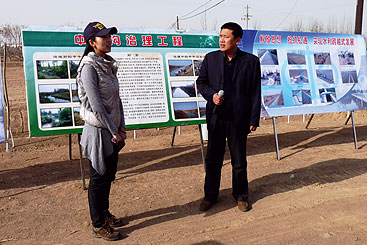The Danube meets China’s Yellow River

The Danube meets China’s Yellow River
Experts from the EU and China are working tougher to establish integrated river basin management practices in the Yellow River Basin.

The EU study mission to the Yellow River Basin focused on China’s experience in water quantity and quality, soil and water conservation and water governance.
Separated by language, culture and thousands of kilometres, the Danube and Yellow Rivers hardly seem to have much in common. But together these two river basins are learning from their differences and exploring their similarities to take on the challenge of integrated river basin management.
eu-chINa RIveR basIN MaNaGeMeNT PRoGRaMMe
The EU-China River Basin Management Programme is designed to share advances in integrated water management and protection gained over the 25 years of implementation of EU water policy and legislation, brought together in the EU Water Framework Directive. The Programme aims to contribute to China’s goal of providing “sustainable management and use of China’s water resources that are compatible with socio-economic development and natural global change.”
On the invitation of the Ministry of Water Resources of China, an EU Study Mission to the Yellow River took place on 6–16 April. The Mission included representatives from nine EU countries, and was supported by the EU China River Basin Management Programme. The mission focused on water quantity, water quality, soil and water conservation and water governance.
Balancing water needs with the environment. With rapid urbanisation, continued expansion of agriculture and the effects of climate change, the demand on water resources compromises environmental objectives. However, efforts by the Yellow River Conservancy Commission have ensured the continuous flow of the river, while securing the basis for a healthy river. This achievement is possible thanks to the introduction of a water allocation system across the nine provinces in the basin in 1999. In particular, a water rights transfer scheme, put in place in Ningxia, has allowed greater water use for industrial development in exchange for more efficient agriculture irrigation.
In the future, cooperation between China and the EU on water quantity issues may focus on prediction and management of drought situations, particularly regarding the effects of climate change. In addition, exchanging knowledge and experience on flood control measures, comparing the implementation of the EU Flood Directive and the Chinese Flood Control Law, would be mutually beneficial.
Making water quality a priority. For both rivers, it is necessary to extend standards and monitoring to cover a wider range of physio-chemical parameters, including groundwater and surface waters, to get a fuller picture of the river basin. Such a monitoring and management system would be a critical step to greater water resource protection.
For China’s Yellow River, major advances have occurred in domestic wastewater treatment, as well as landscape-scale sediment management and control. However, research on new wastewater treatment methods that support effluent reuse and the recovery of important organic matter – such as phosphorus – would benefit China and the EU.
Reducing sediment loads. China’s integrated and comprehensive management plan for sediments has reduced sediment loads by 20% or approximately 450 million tonnes. This has been achieved through the construction of thousands of small sediment dams, large-scale reforestation and soil protection in areas of the Loess Plateau. This has not only prevented further desertification, but has also created new farmland in the soil trapped by dams.
Further cooperation may focus on understanding sediment contamination and its impact on ecosystem functions. From the European side, cooperation could be linked to existing EU research networks such as SEDNET.
Sustaining EU–China cooperation is a major objective given the shared environmental challenges and the opportunities to develop joint solutions. With continued collaboration, river basin managers could bring these two distant rivers even closer together.





